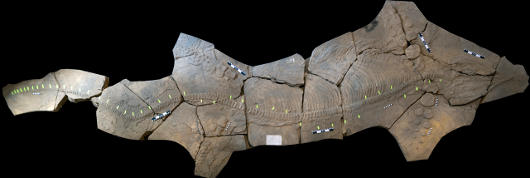Form-Function-Environment relationships in long-term evolution of vertebrates
My ultimate research interest is in how long-term changes in physical environments affect or drive the evolution of vertebrates. Vertebrates interact with their environment through body functions, so form-function relationship plays an important role in my research. I pay special attention to physical principles that are involved in this system at different levels because they are uniformitarian and helpful. I combine laboratory- and field-based research to study this system mainly at three different levels:
Form-Function Relationship
I am interested in how phylogenetic noise blurs the correlation between form and function, and how functional morphologists can combat this problem statistically (ms in review). I have worked on functional morphology of swimming in ichthyosaurs and other marine reptiles (Motani et al., 1996; Motani 2002a, b), and visual optics of large eyes in ichthyosaurs (Motani et al., 1999). There are many more things to investigate concerning swimming evolution of Mesozoic marine reptiles. With my graduate students, I investigated how reptilian eye skeletons allow us to infer ocular optics and associated diel activity patterns (Schmitz and Motani, 2010, in prep), if multivariate skeletal proportions enables identification swimming styles of water birds (Hinic-Frlog and Motani, 2010), and how shell-crushing teeth of fossil chimaeroid enables lower force for shell breakage through utilizing unique fracture patterns (Shin and Motani, in prep).
Environmental change and the evolution of form-function system
I am particularly interested in how changes in sea level affected the evolution of air-breathing marine predators in the Mesozoic. I have shown that the diversification of cruising ichthyosaur was correlated with the long-term rise of sea level in the Late Triassic (Motani, 2008). I am also investigating the correlation between environmental proxies and marine invasion by these vertebrates, as well as their extinction. Together with my colleagues, I am collecting data on marine vertebrate evolution and environmental changes in the Early Traissic through fieldwork I China and Nevada.
Form
At the most basic level, I study morphology using 3D quantitative techniques. Most fossils have been distorted during preservation from various stresses, so it is important to remove such deformation first. This process of distortion removal is called retrodeformation. After exploring 2D retrodeformation (Motani, 1997d), I have been working on several methods to remove distortion in 3D. This line of study led me to investigate fluctuating asymmetry in extant vertebrate skulls because it is essential to know how much asymmetry exists in nature; virtually no data existed in the literature. This in turn allowed me to quantify the statistical distribution of fluctuating asymmetry within an individual vertebrate for the first time (ms in prep).
Fieldwork in China and Nevada
My first visit to an outcrop in China was in 1995. Since 2003, I have been collaborating with Prof. Da-yong Jiang of the Peking University to excavate fossils in the marine Triassic of South and Southwest China. I have had two Naitonal Geographic grants to aid this activity. We found many specimens of Early Triassic marine reptiles this year (2010), coming right out of the cliff.
We usually start by making bed-by-bed columnar sections of the outcrops in the area and collect rock samples for isotope analyses. This allows us to pin point the horizon of the fossils that we find, and compare their occurrence to environmental proxies, such as carbon and oxygen isotopes, from the exact locality.
The same study group is planning to collect the same kind of data on this side of the Pacific (or Panthalassa given the time period), namely in Nevada. I have visited the Lower Triassic exposures in Fossil Hill and am planning a larger scale study with Pat Embree, who owns the land there. A part of this activity will be boradcasted in National Geographic's Naked Science.
Systematics and phylogenetics
I am a systematicist and phylogeneticist too. My systematic studies are usually limited within a clade of marine reptiles called Ichthyopterygia. I published the first phylogenetic hypothesis based on computerized analysis for this group in 1999. I still describe new specimens, analyze their phylogenetic positions, and discuss their systematics. I am also interested in phylogeny reconstruction methods themselves.
